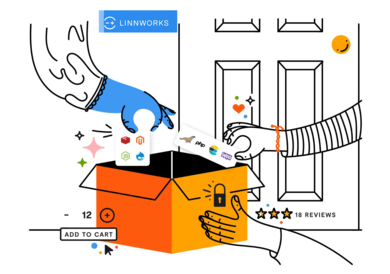
If you’re a complete newbie in API integrations, pause here and go to read our previous articles on the role of APIs in software development, the most secure APIs to select from (GraphQL, REST, etc.), or tips to choose a reliable API integration partner. However, if all that rings a bell to you, then you come here to learn about API integration security, and that’s what we’re going to discuss today, accounting for the alarmingly increasing cases of API attacks.
What is API security?
That’s a cybersecurity approach used to protect your digital ecosystem from the different kinds of malicious threats.
Well, let’s get it clear from the beginning: while APIs are an excellent means of connecting all the systems within one place and reaching business efficiency, they’re vulnerable to malicious risks, including data exfiltration, sensitive data exposure, and account takeover, which, according to Statista, are the key concerns around securing a web API.
Why is API security important?
Usually, to secure an API means safeguarding it from unauthorized users and preventing data leakage and user privacy violations. But that’s what lies on the surface. Think of the identity fraud results: GDPR and HIPAA penalties, reputation risks, loss of customers and finance. If you want to avoid all that, read on to learn the web API security best practices.
Top security measures for APIs
To protect APIs from cybercriminals’ attacks, start with understanding the basic protocols behind securing API integration.
Authentication and authorization protocols
Your first step in securing an API is to limit the service access only to the permitted (authorized) users. The identity check and access guarantee are done through authentication and authorization protocols correspondingly: OAuth 2.0 and OpenID Connect (OIDC) are the key ones here.
How do they work? Thanks to these protocols, the server is entitled to verify the person logging into the system and let them access a certain part of software functionality.
Secure data transmission
The second basic measure to implement for API security in software is data encryption. It’s essential to make your transfer from the client to the server secure. To implement it, rely on Transport Layer Security (TLS) or Secure Sockets Layer (SSL) protocols.
In fact, the latter is the predecessor of the former, so they both work on mitigating data interception risks throughout transmission. Due to encryption, the data looks like a mess of characters, which is impossible to read and use for malicious purposes.
Interested in expert API integration assistance?
Contact UsAPI security best practices
Now that you know the basics, we can discuss securing web services best practices in more detail.
Effective logging and monitoring
Tracking and analyzing all the logs in your system is already part of the answer to the question of how to secure API. Hence, ensure your API is correctly set to identify and record any abnormal user activities. Such tools as Splunk or ELK Stack can be a great help in this regard.
Whatever solution you choose, remember that it’s not sufficient to authenticate users. You should also enable your API system to process the users’ requests to access resources and monitor their actions.
Regular security audits and penetration testing
Remember what we’ve told you about API’s security protocols? Well, to test them at work, you need to implement API security testing, which aims to identify any API vulnerabilities at the different stages of development and timely troubleshoot them.
The process involves regular security audits, which are designed to inspect your API's infrastructure, codebase, and compliance with security standards, and penetration testing to simulate cyberattacks and check the API’s resilience to them.
Strong authentication and authorization checks
Among the numerous securing web API best practices, we’d like to place a separate emphasis on authentication and authorization. Why? In the worst scenario, the weaknesses in user verification and access grants may result in a full system compromise. Therefore, these are the defence mechanisms that should be taken seriously.
Let’s start with authentication. The task is to guarantee the system access only to legitimate users. This can be done through multi-factor authentication, leverage of short-lived access tokens, or token blacklisting. Choose one method for one type of resource at a time.
Now, a few words about authorization. In this case, it’s turn to determine what information and functionality scope the user will get access to. To make this method work robustly, you’ll rely on an OAuth server. With its help, the user will get permission to limitedly access resources without sharing their identity (short-lived tokens are used instead of passwords).
Encrypting data in transit and at rest
When we think of data exchange between the server and the API endpoint, there are two states, where we can find data—in transit and at rest. The former indicates the continuous movement of data across the network, while the latter implies the result of this process—its storage on a disk. To make this information transfer safe, it should be encrypted—converted into an unreadable format—as one of the REST API security best practices.
Implementing rate limiting
Another question for you to ponder over is how to secure API calls. The answer is to set the limitations for the number of API requests the user can make within a given moment. This measure will queue the API calls to be processed with more diligent control and prevent malicious attacks. The easiest way to put it into practice is by using API gateways, such as AWS and Kong.
Using API gateways
Our final advice to safeguard your APIs from fraud threats is to apply API gateways. This means selecting a gateway with a high-level filtering potential to block suspicious users, treating each API request with a proper check, and even gathering logging and other business metrics.
The importance of secure API integrations
Today, APIs are essential for how different software systems connect. They let businesses add features and improve how users interact with their products. However, because APIs connect so many systems, they also create real security risks.
These risks are something companies must address.
✓ Compliance with data protection regulations
Keeping API integrations secure is crucial. It's how we comply with data protection laws like GDPR and HIPAA. If we don't, we risk serious fines, legal problems, and losing our customers' trust. Strong security protects sensitive data, which is essential for both our organization and our clients. We must handle data correctly to meet these regulations.
✓ Preservation of organisational reputation
A data security lapse can severely damage a company's image. If weak API security leads to exposed sensitive data, customers will likely lose trust. This can cause them to leave, and generate negative public attention. On the other hand, strong API security builds trust. It can also give a company a real advantage in the market.
✓ Facilitation of business growth and revenue
Strong security for your API connections is more than just protecting what you already have. It's also a key to unlocking future business growth. Many companies now look for partners with solid security measures. If you can show your API security is robust, you'll attract and keep clients who care about their data. This can lead to opportunities to offer more services and increase your income.
Incorporating secure API integrations is not merely a technical necessity but a strategic business imperative. It ensures compliance with legal standards, maintains and enhances reputation, and fosters sustainable growth by building trust with customers and partners.
How do API security risks affect your company?
APIs are integral to business operations, enabling seamless data exchange and functionality across platforms. However, inadequate API security can expose organisations to significant risks, impacting various facets of the business.
• Financial implications
Vulnerable APIs present a serious security risk, and breaches can lead to significant financial consequences. These costs can quickly escalate, encompassing incident response, system repairs, legal expenses, and regulatory penalties. A recent example of this involved the U.S. Treasury Department.
They experienced a major security incident where a state-sponsored actor exploited weaknesses in third-party software. This resulted in unauthorized access and the potential for substantial financial repercussions.
• Operational disruptions
Vulnerabilities within APIs can significantly disrupt business operations, leading to operational downtime and decreased productivity. To illustrate, consider the case involving Kia's web portal. Security researchers discovered weaknesses that allowed unauthorized individuals to remotely track and, in some cases, control vehicles. This incident underscores the potential for serious operational disruptions when API security is compromised.
• Legal and regulatory consequences
When companies don't properly secure their APIs, they risk breaking data protection laws. This can lead to serious legal problems and large fines. Simply put, businesses must protect sensitive data. If they fail, they face heavy penalties. For example, recently, the Chinese AI platform DeepSeek had a major issue. They exposed a database with over a million API authentication tokens. This situation highlights the real legal dangers of weak API security.
• Reputational damage
Customer trust is absolutely essential. If a company has a security problem, it can really hurt that trust. People might leave, and it can create bad press. For example, Transport for London had a cyberattack that exposed the personal information of about 5,000 customers. That kind of thing can definitely damage how people view the organisation.
• Competitive disadvantage
Poor API security can really hurt a company's standing. Clients and partners want to work with businesses that take data protection seriously. It's about trust. Look at the AI industry. Even with concerns about security, companies like DeepSeek in China have made rapid progress, and this intensifies the competition. This shows how crucial strong security is for staying ahead. If you don't protect your data, you risk falling behind.
In conclusion, neglecting API security can have far-reaching consequences, affecting a company's financial health, operational efficiency, legal standing, reputation, and market position. Proactively addressing API security risks is not just a technical necessity but a strategic imperative for sustained business success.
Interested in expert API integration assistance?
Contact UsHow Patternica supports fintech transformation through secure APIs
At Patternica, we help fintech firms not just integrate APIs, but do so securely, so they can scale with confidence, operate smoothly, and stay compliant, all while delivering great user experiences.
How we support our fintech clients with API security:
→ Secure cloud-native development
We build cloud platforms with security baked in from day one - using encrypted storage, hardened microservices, and strict network controls. In our Payment Gateway Integration project, we combined TLS-enforced endpoints with rigorous key management to keep transactions both fast and protected.
→ Robust API integration & gateway setup
Beyond just wiring systems together, we configure API gateways (Kong, AWS API Gateway) to enforce rate limits, validate tokens, and block malicious traffic. When assisting a German fintech startup’s team expansion, we not only grew their dev capability but implemented a zero-trust API perimeter - cutting potential attack surfaces in half and accelerating their secure launch.
→ Compliance-driven custom platform builds
Every custom lending platform or mobile banking app we deliver includes embedded audit trails, role-based access controls, and dynamic token revocation - so you meet PSD2, GDPR, and KYC/AML without extra months of work.
→ AI & data-driven threat detection
For a German AI fintech startup scaling their team, we crafted real-time anomaly detectors - using ML to spot unusual API usage patterns, then auto-quarantine suspicious requests before they ever reach your core systems.
→ Ongoing security ops & DevSecOps
Secure APIs aren’t “set and forget.” We embed continuous scanning, log aggregation (ELK/Splunk), and automated penetration tests into your CI/CD pipelines - so every code change is vetted, every week, without slowing down feature delivery.
Get your API integrations built securely with Patternica
To enjoy the fruits of API integration, you first need to create a safe environment for its building, testing, and implementation. It should be much easier with our list of top API security measures and an explanation of key concepts. However, you can gain more by ordering our custom API integration and development services.
Make your company’s reputation a priority, and choose Patternica to ensure the safety of your APIs and show that you care about users.
FAQ
What are the common API security risks?
Common API security risks:
- Injection attacks: Such as SQL or command injections, where malicious data is sent to an interpreter, leading to unauthorised data access or system compromise.
- Broken authentication: Flaws that allow attackers to compromise authentication tokens or exploit implementation weaknesses to assume other users' identities.
- Sensitive data exposure: Inadequate encryption or improper data handling can lead to unauthorised access to sensitive information.
- Lack of rate limiting: Absence of restrictions on the number of requests can lead to denial-of-service attacks or facilitate brute-force attacks.
- Broken object level authorisation: Improper authorisation checks can allow access to unauthorised objects or data.
What tools can you use to test API integrations' levels of security?
Several tools are available to assess the security of API integrations:
- Burp suite: A comprehensive platform for security testing of web applications, offering features like scanning, crawling, and advanced manual testing tools.
- OWASP ZAP (Zed Attack Proxy): An open-source tool that helps find security vulnerabilities in web applications during development and testing.
- Postman: While primarily an API development environment, it also offers testing capabilities to validate API responses and security.
- Parasoft SOAtest: Provides automated testing for APIs, including functional and security testing, to ensure robust API performance.
How can you make APIs more secure?
To enhance API security:
- Implement strong authentication and authorisation: Ensure that only authorised users can access the API, using robust authentication mechanisms like OAuth.
- Use encryption: Employ TLS/SSL protocols to encrypt data in transit, protecting it from interception.
- Validate and sanitise inputs: Always validate incoming data to prevent injection attacks and ensure data integrity.
- Enforce rate limiting: Implement controls to limit the number of requests from clients, mitigating the risk of abuse and denial-of-service attacks.
- Regular security testing: Conduct periodic security assessments using tools like Burp Suite or OWASP ZAP to identify and address vulnerabilities.
What are common examples of API attacks?
Common API attacks include:
- Injection attacks: Attackers exploit vulnerabilities by injecting malicious code into API requests, leading to unauthorised data access or system compromise.
- Man-in-the-Middle (MitM) attacks: Intercepting and potentially altering communications between the client and server, especially when data is unencrypted.
- Distributed Denial-of-Service (DDoS) attacks: Overwhelming the API with a flood of requests to disrupt service availability.
- Credential stuffing: Using leaked or stolen credentials to gain unauthorised access to user accounts through the API.
- Business logic attacks: Exploiting flaws in the API's design to perform unintended actions, such as bypassing workflows or manipulating data.


.png)